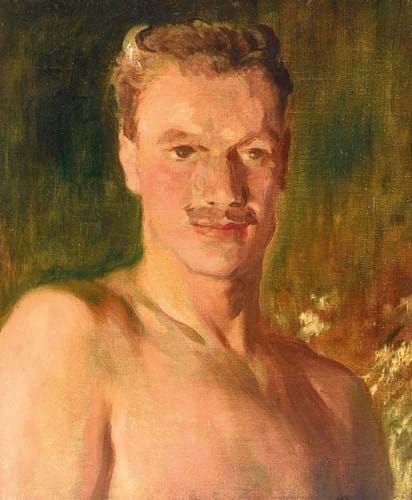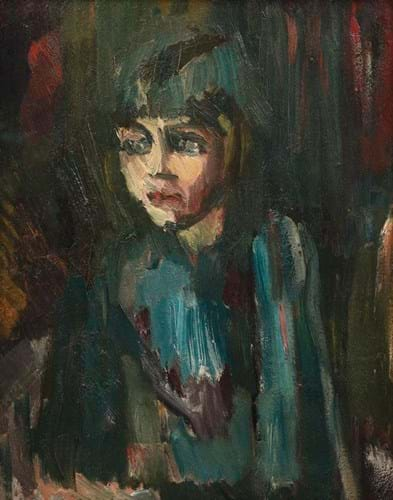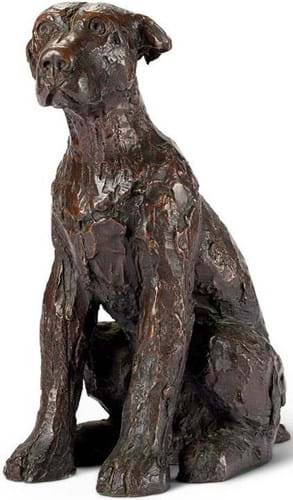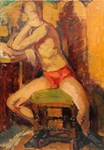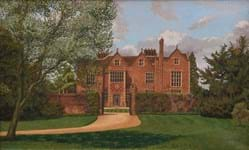The top lot of the sale in Newbury, Berkshire, on March 15 was a portrait by Glyn Philpot (1884-1937). It depicted the American heir and noted art collector Robert Allerton and had recently featured in Simon Martin’s 2022 book Glyn Philpot, Flesh and Spirit.
Allerton was the son of Samuel Waters Allerton, a wealthy Chicago livestock trader who co-founded the First National Bank of Chicago.
Determined not to follow in his father’s footsteps, the younger Allerton initially tried to become an artist, studying at the Royal Academy of Fine Arts in Munich. Despite further study in Paris, he returned to Illinois to run the family farms after five years abroad.
Building a mansion on the estate that served as a venue for lavish parties attended by his friends, artists as well as members Chicago elite, in 1906 he was described as the ‘richest bachelor in Chicago’ by the Chicago Tribune.
Philpot, having previously met Allerton at the Royal Opera House in London, sailed to the US in September 1913 and Allerton arranged a studio space for him to work at his estate, inviting close friends to have their portraits painted. Philpot ended up staying in Illinois for four months.
He is known to have produced two portraits of Allerton: the current work which was believed to be a study for a larger painting as well as a portrait titled The Man in Black, now in the collection at Tate Britain.
It seems that Allerton had a penchant for the faun character – during a later visit Philpot produced a painting titled Faun and Satyr which was hung above the over-mantel (it was later destroyed in a hurricane at Allerton’s estate in Hawaii), while Allerton is also kept statues and reliefs showing mythological fauns in his garden.
Philpot and Allerton are not believed to have had a sexual relationship but in letters written to his sister, Philpot described him as ‘the most beautiful wise mature character’.
The Dreweatts catalogue described the 15½ x 12¼in (40 x 32cm) oil on canvas as a ‘sensitive and intimate portrait’.
While this was certainly the case, a number of factors meant it was unlikely to reach the six-figure highs the artist has reached on a number of occasions in the past, not least due to its smaller size.
The highest sums for Philpot have come for portraits of black men, including one that fetched a record £300,000 at Christie’s in 2018.
This picture had previously appeared at auction at Phillips in 1988. Back then, it was unsold against a £3000-4000 estimate and had been purchased by Dreweatts’ vendor not long afterwards.
The market for the artist has moved on greatly since then, as was demonstrated here. Estimated at £15,000-20,000, it drew considerable interest and was eventually knocked down at £60,000 to a UK private buyer.
The sum stands within the top 20 prices for the artist and appears to be the highest at a UK auction outside London according to Artprice.
Bomberg portrait
Another highly personal work at the sale by a major Mod Brit artist was a portrait by David Bomberg (1890-1957) of his step-daughter Dinora.
The consignment followed Dreweatts’ lucrative sale of 14 paintings by the artist that generated a combined £685,600 in October.
The 2ft 7in x 2ft (79 x 61cm) oil on canvas from 1930 was one of a number of paintings he made of Dinora at different ages. Records show that five of them have sold at auction over the last 30 years, with the most expensive being a later example from the David Bowie collection that sold for £32,000 at Sotheby’s in 2016.
The example in Newbury was pitched at the lower level of £6000-8000 which helped it attract interest from a number of parties, and it was knocked down at £19,000 to a private UK buyer bidding online.
Frink works
The auction also offered a group of 12 sculptures and pictures by Dame Elisabeth Frink (1930-93) from the estate of the late Jean Marsden, a passionate collector of works by Frink as well as other 20th century sculptors. With all bar one work selling, the Frink lots raised a combined £202,400.
The top price came for an 11¼in (29cm) high bronze titled Dog (childhood sculpture). Part of a charity edition from 1993 commissioned by The Morris Singer Foundry and sold in aid of Great Ormond Street Hospital for Children, the canine bronze was part of an intended edition of 350 but, after Courcoux & Courcoux Gallery took over the management of pre-existing Morris Singer casts, the edition became limited to 50 as well as to six artist copies.
A relatively large edition for Frink, the £60,000-80,000 pitch at the auction proved slightly punchy for a late work such as this and it got away at £55,000.

Study for Alcock and Brown Memorial (Horizontal Birdman), a bronze by Elisabeth Frink, £32,000 at Dreweatts.
Bringing more competition was Study for Alcock and Brown Memorial (Horizontal Birdman) which was part of an edition of nine bronzes conceived in c.1962.
Marsden had acquired it from London gallery Beaux Arts in 2005. It was a maquette neasuring 15½in (40cm) long for Frink’s 1962 commission for Manchester Airport: a full-scale bronze dedicated to aviators John Alcock and Arthur Brown who made the first non-stop transatlantic flight in June 1919.
Only a few examples of the maquette have emerged at auction before, including one that made £15,500 at Duke’s of Dorchester in April 2019. That price may have led to the £10,000-15,000 estimate here but, with Frink’s market having also notably expanded in recent times, it was bid to £32,000.
The Marsden consignment helped lift the total at Dreweatts to £1.04m (including premium) from 145 lots. The sell-through rate was 86%.


